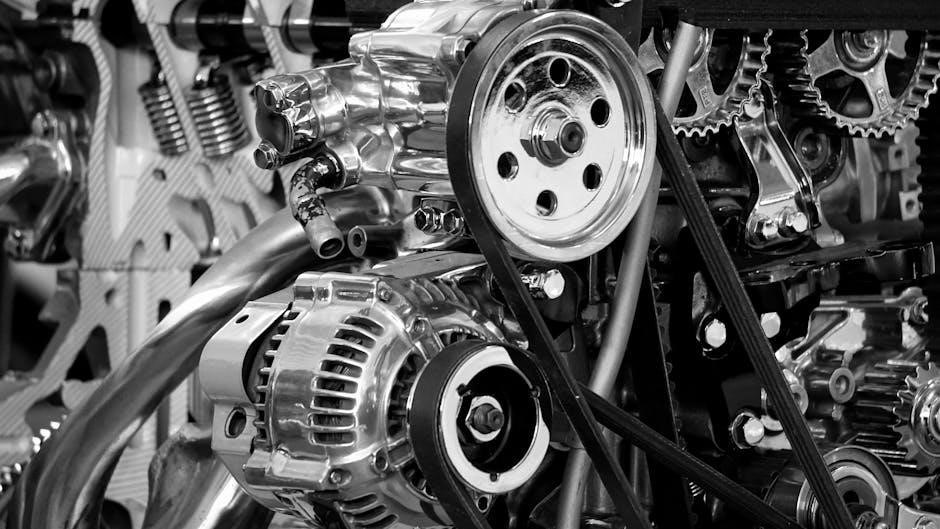The 4L60 manual transmission offers a unique blend of performance control and improved fuel efficiency by converting from automatic to manual operation.
Converting the 4L60 to manual control provides driver engagement and potential fuel savings, making it a popular modification for enthusiasts seeking enhanced drivetrain control.
1.1 Overview of the 4L60 Transmission
The 4L60-E is a versatile, electronically controlled automatic transmission designed for rear-wheel-drive vehicles. Based on the 700-R4, it adds electronic controls for improved performance and efficiency. Known for its reliability, it is widely used in trucks, SUVs, and performance cars.
Its compact design and strength make it suitable for both stock and high-performance applications. The 4L60-E features a 4-speed gear set with electronic shift control, enhancing driver engagement and fuel economy, making it a popular choice for enthusiasts and technicians alike.
1.2 Brief History and Development
The 4L60-E transmission evolved from the iconic THM 700-R4, introduced in the 1980s. It was later updated with electronic controls in the early 1990s to improve shifting precision and efficiency. This evolution marked a significant step in automatic transmission technology, blending reliability with modern performance capabilities. Its development catered to the growing demand for smoother and more efficient power delivery in various vehicle applications, solidifying its reputation as a durable and versatile transmission system.
1.3 Key Features and Specifications
The 4L60-E features a 4-speed automatic design with electronic controls, offering precise shifting and improved fuel efficiency. It includes a torque converter clutch (TCC) system, reducing heat and enhancing mileage. The transmission is rear-wheel drive, with a 27-spline output shaft, suitable for various engine applications. Its compact design and robust construction make it a reliable choice for both everyday driving and performance modifications, ensuring durability under diverse operating conditions.

Understanding the 4L60-E Automatic Transmission
The 4L60-E is an electronically controlled, 4-speed automatic transmission designed for rear-wheel drive vehicles, enhancing performance and efficiency with solenoid-controlled shifts and a torque converter clutch.
2.1 Electronic Control and Functionality
The 4L60-E features advanced electronic control systems, with a Powertrain Control Module (PCM) managing shift patterns via solenoids. These solenoids regulate fluid pressure for seamless gear transitions, optimizing performance and fuel efficiency. The Torque Converter Clutch (TCC) system enhances operation by locking the torque converter, reducing slippage and heat generation. This electronic oversight ensures precise control over transmission functions, adapting to driving conditions for smooth and efficient power delivery.
2.2 Shift Patterns and Solenoid Operation
The 4L60-E employs electronic solenoids to control shift patterns, with the Powertrain Control Module (PCM) providing precise signals for seamless gear transitions. These solenoids manage hydraulic pressure, ensuring smooth engagement of clutches and bands. The transmission’s adaptive shift logic adjusts to driving conditions, optimizing performance and fuel efficiency. Solenoid operation is critical for maintaining proper shift timing and torque delivery, making the 4L60-E a reliable choice for both stock and modified applications.
2.3 Torque Converter Clutch (TCC) System
The Torque Converter Clutch (TCC) system in the 4L60-E enhances fuel efficiency by locking the torque converter, reducing slippage during higher gear operation. Controlled by the Powertrain Control Module (PCM), the TCC engages based on speed and load conditions. This system minimizes heat generation and optimizes power transfer, especially in cruising or light-load situations. Proper TCC operation is crucial for maintaining transmission performance and efficiency, ensuring smooth and reliable drivetrain functionality across various driving scenarios.
Conversion to Manual Transmission
Converting the 4L60 to manual control offers enhanced driver engagement and potential fuel efficiency improvements, making it a popular modification for performance enthusiasts and custom builds.
3.1 Benefits of Manual Control
Converting the 4L60 to manual control enhances driver engagement and offers improved fuel efficiency by reducing heat and wear on the transmission system.
Manual operation provides precise gear control, reducing slippage and optimizing performance in high-stress conditions like racing or heavy towing.
It also allows for better customization of shifting patterns, catering to specific driving styles or vehicle modifications, making it versatile for various applications.
This conversion is particularly appealing for enthusiasts seeking a cost-effective way to improve both performance and longevity of their transmission system.
3.2 Required Components for Conversion
To convert the 4L60 to manual control, essential components include a manual valve, shift kit, and torque converter clutch system.
Additional parts like a transmission cooler, high-capacity clutch packs, and reinforced bands are recommended for durability in high-stress conditions.
The process also requires a compatible manual shifter and linkage system to ensure smooth gear transitions and precise control.
Using high-quality components ensures longevity and optimal performance, making the conversion both reliable and efficient.
3.3 Step-by-Step Conversion Process
Begin by removing the automatic components, such as the manual valve link and parking lock actuator, to prepare for manual operation.
Install a manual shift kit, including a torque converter clutch system, to enable driver-controlled gear shifts.
Adjust the shift patterns and solenoid operation to align with manual functionality, ensuring smooth transitions between gears.
Finally, test the system to confirm proper engagement and operation of the manual transmission setup.
3.4 Tools and Equipment Needed
The conversion process requires specialized tools, including a transmission pan gasket set, torque wrench, and solenoid testers.
- A set of metric and SAE wrenches and sockets for disassembly and reassembly.
- A hydraulic press for replacing bearings and other press-fit components.
- A transmission fluid pump and filter replacement kit to ensure proper lubrication.
- A diagnostic scanner to recalibrate the transmission control module (TCM) for manual operation.
Additional tools like a dial indicator and bearing puller may be necessary for precise adjustments and component removal.

Troubleshooting Common Issues
Identifying issues like slipping gears or delayed shifts requires diagnostic tools and a thorough inspection of solenoids and clutch packs for wear or malfunctions.
4.1 Diagnosing Transmission Problems
Diagnosing issues in a 4L60 manual transmission involves identifying symptoms like slipping gears or delayed shifts. Scan tools can detect fault codes, while physical inspections focus on solenoids, clutch packs, and seals. Monitoring fluid condition and pressure levels helps pinpoint internal wear or blockages.
Electronic controls require checking solenoid resistance and wiring connections. Manual valve operation ensures proper gear engagement. Regular maintenance, such as fluid changes, prevents overheating and extends transmission life. Early detection of problems avoids costly repairs.
4.2 Common Faults During Manual Operation
Common faults during manual operation of a converted 4L60 transmission include erratic shifting, unexpected gear engagements, and solenoid malfunctions. These issues often stem from improper wiring or faulty solenoids controlling the shift patterns. Additionally, manual valve link adjustments may be off, causing misalignment in gear engagement. Overheating due to excessive friction can also occur, leading to premature wear of clutch packs and bands. Addressing these faults requires precise adjustments and thorough inspection of electronic and mechanical components to ensure smooth operation. Regular maintenance is crucial to prevent such issues.
4.3 Solutions and Repair Techniques
Solutions for manual operation faults in a 4L60 transmission involve recalibrating shift solenoids and ensuring proper wiring connections. Adjusting the manual valve link and parking lock actuator can resolve gear engagement issues. Replacing worn clutch packs and bands, along with flushing and refilling transmission fluid, helps restore performance. Upgrading to heavy-duty components enhances durability. Regular inspections and following detailed repair manuals are essential for maintaining optimal function and preventing future malfunctions.

Maintenance and Upkeep
Regular fluid replacements and filter maintenance are crucial for optimal performance. Inspect solenoids, clutch packs, and bands for wear. Adjustments and timely repairs ensure longevity and smooth operation.
5.1 Fluid Replacement and Filter Maintenance
Regular fluid replacements and filter maintenance are essential for optimal transmission performance. Replace the transmission fluid every 30,000 to 60,000 miles to prevent contamination. Ensure the filter is changed every 15,000 to 30,000 miles to maintain clean fluid flow. Use the correct type of automatic transmission fluid (ATF) specified for the 4L60. Neglecting fluid and filter maintenance can lead to premature wear and potential damage to internal components. Always follow the manufacturer’s recommendations for fluid capacity and type to ensure longevity and smooth operation.
5.2 Regular Inspection and Adjustment
Regular inspection of the 4L60 transmission ensures optimal performance and prevents potential issues. Check fluid levels and condition, and inspect for leaks around seals and gaskets. Verify pan bolts are tightened to the correct torque specification and ensure the filter is clean or replaced as needed. Adjustments may be required for the throttle valve cable or manual linkage to maintain proper shift timing. Follow the manufacturer’s guidelines for inspection intervals and adjustments to keep the transmission functioning smoothly and reliably over time.
5.3 Tips for Longevity and Performance
To maximize the lifespan and performance of your 4L60 manual transmission, regular fluid changes are essential. Use high-quality transmission fluid suitable for your application. Avoid aggressive driving habits, such as rapid shifting or riding the clutch, as this can cause excessive wear on components. Ensure proper alignment of the driveshaft to prevent vibration damage. Keep the transmission cool by maintaining adequate airflow, especially in high-stress conditions. Finally, address any unusual noises or behaviors promptly to prevent minor issues from becoming major repairs.

Performance Upgrades
Performance upgrades for the 4L60 manual transmission include enhancing torque capacity, upgrading clutches and bands, and installing a heavy-duty torque converter for improved power handling and durability.
These modifications ensure the transmission can withstand high-stress situations like racing or aggressive driving, delivering enhanced reliability and performance under demanding conditions.
6.1 Enhancing Torque Capacity
Enhancing the torque capacity of the 4L60 manual transmission involves upgrading key components such as the input shaft, output shaft, and gear sets to handle increased power loads.
High-strength materials and advanced manufacturing techniques ensure these parts can withstand the added stress, making the transmission more durable and reliable under high-torque conditions.
6.2 Upgrading Clutches and Bands
Upgrading the clutches and bands in a 4L60 manual transmission enhances performance and durability. High-performance materials, such as carbon fiber clutches and high-friction bands, improve heat resistance and increase the transmission’s holding capacity, making it suitable for high-stress applications like racing or heavy towing.
Proper installation techniques, including precise alignment and clearance adjustments, ensure optimal functionality. Regular maintenance, such as cleaning and adjusting the clutches and bands, helps prevent wear and extends the transmission’s lifespan, ensuring consistent performance over time.
6.3 Installing a Heavy-Duty Torque Converter
Installing a heavy-duty torque converter in a 4L60 manual transmission significantly enhances performance and durability. High-performance torque converters, such as Stallion Performance or similar models, are designed to handle increased torque and horsepower, making them ideal for high-stress applications like racing or heavy towing.
These converters often feature improved lock-up clutch systems and optimized stall speeds, ensuring smoother power delivery and better fuel efficiency. Proper installation requires precise alignment with the transmission’s input shaft and adherence to torque specifications to prevent damage and ensure optimal functionality.
The 4L60 manual transmission offers a blend of performance and efficiency, making it a popular choice for drivers seeking enhanced control and improved driving dynamics.
7.1 Summary of Key Points
The 4L60 manual transmission conversion offers enhanced driver control and potential fuel efficiency improvements. It involves modifying the electronic automatic transmission to operate manually, requiring specific components like shift solenoids and a torque converter clutch. Regular maintenance, such as fluid replacements and inspections, ensures longevity and performance. While the process demands specialized tools and expertise, the benefits of manual operation make it a popular choice for enthusiasts. Proper setup and care are crucial to maximize the transmission’s durability and functionality in various driving conditions.
7.2 Final Thoughts on Manual Conversion
Converting the 4L60 to manual operation offers a rewarding blend of control and efficiency, appealing to driving enthusiasts. While the process requires technical expertise and specialized tools, the benefits of manual shifting, improved fuel economy, and driver engagement make it a worthwhile modification. Proper setup and regular maintenance are essential to ensure optimal performance and longevity. For those willing to invest time and effort, the 4L60 manual conversion delivers a unique driving experience that combines modern technology with classic manual control.

